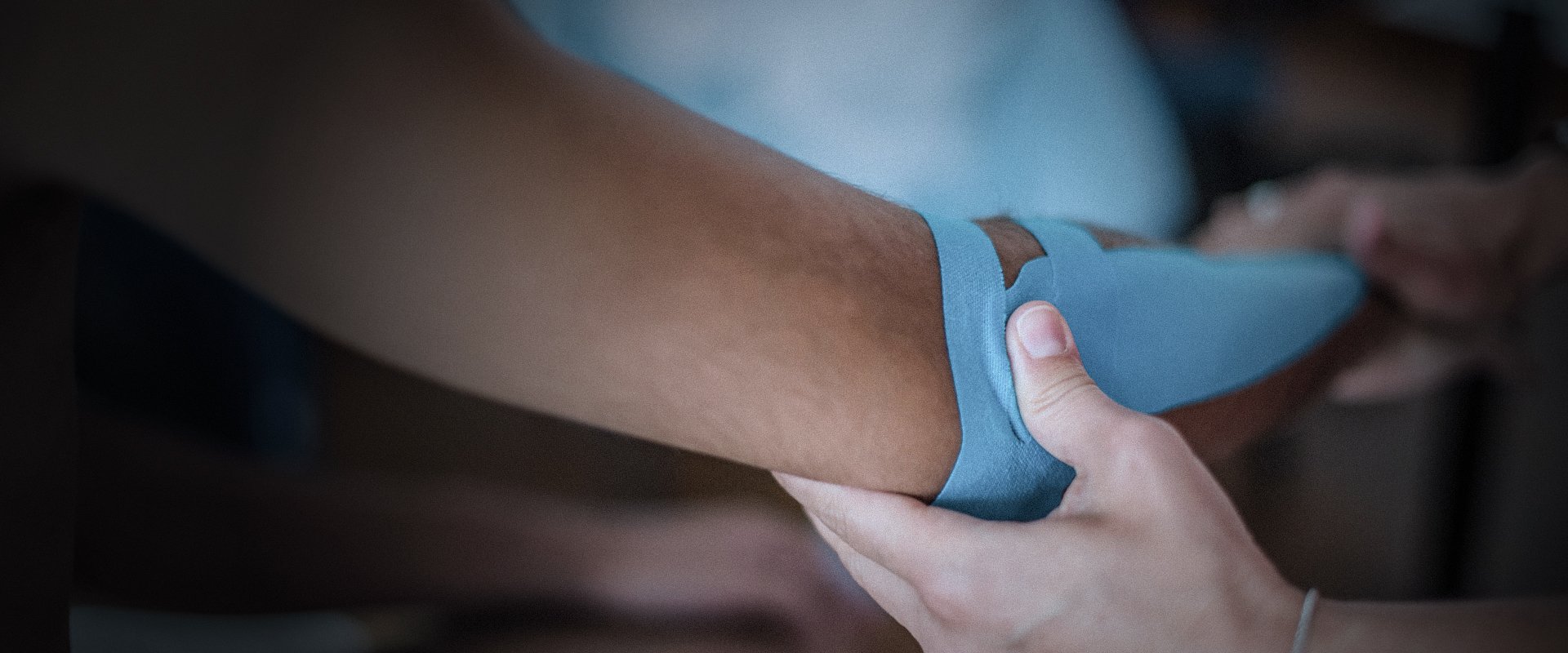
Kinesio Taping for Elbow Pain
AT EVOLVE
Kinesio Taping for Elbow pain
HOW CAN KINESIO TAPING HELP MY ELBOW PAIN?
If you are experiencing elbow pain or recovering from an injury, your physical therapist might suggest taping as a tool to complement your rehabilitation program. While there are many types of medical tape on the market, forty years ago, a dynamic type of tape was invented for use in the rehabilitation setting and has since been used to address many injuries and conditions. This tape is known as Kinesio® Tape. Kinesio Tape, when applied to the elbow, can have many effects on the underlying tissue including improving pain symptoms.
WHAT IS KINESIO® TAPE?
If you have ever seen athletes wearing black, tan or brightly-colored tape on their shoulders, knees or ankles, you may be familiar with Kinesio Tape. Kinesio Tape is an elastic, therapeutic taping modality used in many different populations from young children to professional athletes. Kinesio Tape can be applied in many different ways using the Kinesio® Taping Method and is intended to reduce pain and inflammation, re-educate the neuromuscular system, promote healing, lymphatic drainage and good circulation to the area beneath the tape.
WHAT IS THE KINESIO TAPING METHOD?
The Kinesio Taping Method was developed by Dr. Kenzo Kase in 1979. It was developed as a therapeutic method of taping to provide not only external support but also help rehabilitate injuries and address physiologic dysfunction. Therapists using Kinesio Tape first evaluate the client’s specific needs and impairments in order to determine the location of the taping, the shape of the tape application, the direction and the amount of stretch. The assessment also determines what other interventions will be utilized in addition to the Kinesio Taping. Kinesio Taping is typically just one part of a comprehensive rehabilitation program, however, some patients may continue to use Kinesio Tape in certain scenarios following discharge from physical therapy.
KINESIO TAPING TECHNIQUES FOR ELBOW PAIN
Kinesio Tape is typically used as part of a comprehensive rehabilitation program to reduce pain and inflammation, relax or stimulate the muscles and promote lymphatic flow. Given the goals of this taping technique, Kinesio Taping can benefit clients dealing with many different types of painful elbow conditions such as tennis elbow, golfer’s elbow and elbow inflammation caused by injury.
APPLICATIONS OF KINESIO® TAPE FOR ELBOW PAIN
Elbow pain can have many causes. Inflammation or degeneration of the tendons near the elbow can cause painful tendonitis or tendinopathies. Golfer’s elbow and tennis elbow are examples of this condition affecting the tendons that attach on the inner and outer sides of the elbow. An acute injury such as a fall can cause bruising, hematomas and inflammation at the elbow, all of which can cause pain. Additionally, neurologic conditions like a stroke, spinal cord or peripheral nerve injury can cause muscle weakness around the elbow that results in pain.
Kinesio Tape is designed to affect the underlying nerves and tissues in many different ways which can help address painful symptoms in the elbow. When Kinesio Tape is placed on the skin, it lifts the skin microscopically forming what are called convulsions, or small spaces beneath the layers of skin which allow for increased lymphatic drainage and a reduction in inflammation. If you have swelling or painful inflammation around the elbow from an injury or surgery, your therapist may apply a taping technique to promote the flow of fluid out of the tissues.
A hematoma or deep tissue bruise can result from a blow to the elbow. This injury causes a hardened, purple and swollen bruise and collection of blood in the muscle. Physical therapists sometimes apply Kinesio Tape in a shape that looks like an octopus to help direct blood and inflammation out of the area.
When muscles are strained or overworked such as can be the case following a neurologic injury that weakens the muscles around the elbow, Kinesio Tape can be applied on the affected muscles to reduce pain and improve circulation in the area.
When elbow pain is caused by overuse conditions like tennis elbow or golfer’s elbow, Kinesio Tape can be applied to the affected tendons to reduce load through the elbow, reduce friction and rubbing of the tendons, increase circulation and blood flow to the area, alter painful nerve signals and improve body awareness of movement at the elbow.
The tape is often applied on the elbow in an “I”, “X” or “Y” pattern though other patterns may be used as well. The tension or stretch of the tape can be modified and customized to achieve different results. The tape has three zones. The anchor is the first spot where the tape is applied to the skin. At the other end of the tape is the base. In between the anchor and the base is the therapeutic zone which can be modified by the clinician by applying more or less tension on the tape. The amount of tension on the tape and the direction in which it is stretched across the skin and muscles determines the effect of the tape on the elbow and surrounding tissue.
End Injury Progression
Kinesio Taping for elbow pain has proven to prevent injury, slow and even stop pain issues, improve performance, and reverse injury progression in many cases.
Relieve Pain
The movements used in this technique can target your entire body helping you to manage discomfort and pain during the course of your physical therapy treatments.
Improve Range of Motion
Posture awareness is an important area to focus on due to the fact that certain positions may cause you further discomfort and pain.
Restore Mobility
You can regain mobility and flexibility by taking part in the stretches and exercises as prescribed by your physical therapist.
How Long Will Physical Therapy for Kinesio Elbow Last?
If you decide to work with a physical therapist to help correct your elbow issues, your entire treatment plan could consist of around 8-20+ different physical therapy sessions that will each last 60-90 minutes. Once you complete your customized rotator cuff physical therapy treatment plan, you will be able to continue to do the prescribed stretches and exercises utilized during your rotator cuff PT sessions yet in the comfort of your own home.
PHYSICAL THERAPY INTERVENTIONS FOR PIRIFORMIS SYNDROME
Conservative treatment for piriformis syndrome is the first line approach. This may include pharmacological treatments like NSAIDs or muscle relaxers and almost always physical therapy. Treatments for piriformis syndrome will always be individualized to address a patient’s impairments but several physical therapy interventions have been shown to be helpful in the management of this condition:
Lifestyle modification: lifestyle modification to reduce compression or irritation of the sciatic nerve can be helpful in reducing symptoms. Avoiding sitting for prolonged periods and daily stretching for example are often recommended.
Modalities: modalities like ultrasound, hot or cold therapy can be utilized to reduce inflammation, promote tissue healing and reduce pain and spasms which may be beneficial early on in a treatment session.
Manual therapy: addressing myofascial restrictions, trigger points and other restrictions in soft tissue around the glutes may be important to address your symptoms. Your therapist may perform these interventions using their hands or may employ other tools like dry needling, foam rolling or IASTM.
Stretching: stretching of the piriformis muscle can address muscle length issues and may help alter pain sensations and decrease muscle spasms to reduce compression on the sciatic nerve.
Lumbar and sacral spine-focused treatments: your therapist may direct their treatment to the spine itself if they feel this is a contributing factor to symptoms. Manual therapy techniques and exercises may be prescribed to address these impairments.
Muscle strength and performance exercises: if biomechanical factors are thought to be contributing to piriformis syndrome your therapist may prescribe a series of functional hip and gluteal strengthening exercises to ensure the small piriformis muscle isn’t trying to do the work of these larger muscles.
Functional training and restoration of activity: as underlying factors are addressed and symptoms subside, your therapist will incorporate more functional activities to ensure proper biomechanics, motor control and coordination when performing these activities. They will also educate you on how to return to your prior level of activity with an eye on prevention of piriformis syndrome in the future.
The symptoms of piriformis syndrome can surely be a pain but you should feel confident that the physical therapists at Evolve Physical Therapy know how to help. Call today to schedule an initial evaluation.
Mill Basin (located in Harbor Fitness)
6161 Strickland Ave
Brooklyn, NY 11234
Monday: 7am-8pm
Tuesday: 7am-8pm
Wednesday: 8am-5pm
Thursday: 7am-8pm
Friday: 8am-1pm
Park Slope (located in Harbor Fitness)
550 5th Ave.
Brooklyn, NY 11215
Monday: 9am-8pm
Tuesday: 8am-6pm
Wednesday: 9am-8pm
Thursday: 8am-6pm
Friday: 8am-3pm
Gravesend
372 Avenue U
Brooklyn, NY 11223
Monday-Thursday: 8am-8pm
Friday: 8am-3pm
Kings Highway
945 Kings Highway
Brooklyn, NY 11223
Monday-Wed.: 12pm-8pm
Ready to take the next step to a healthier you?
Contact Us Today!
KINESIO TAPING FOR ELBOW PAIN
Need kinesio taping for elbow pain?
Let our caring and compassionate physical therapists help you with relieving pain while getting you back on your feet comfortably.
Call now to schedule your first PT consultation free of charge.
Call: 1-718-690-3229







